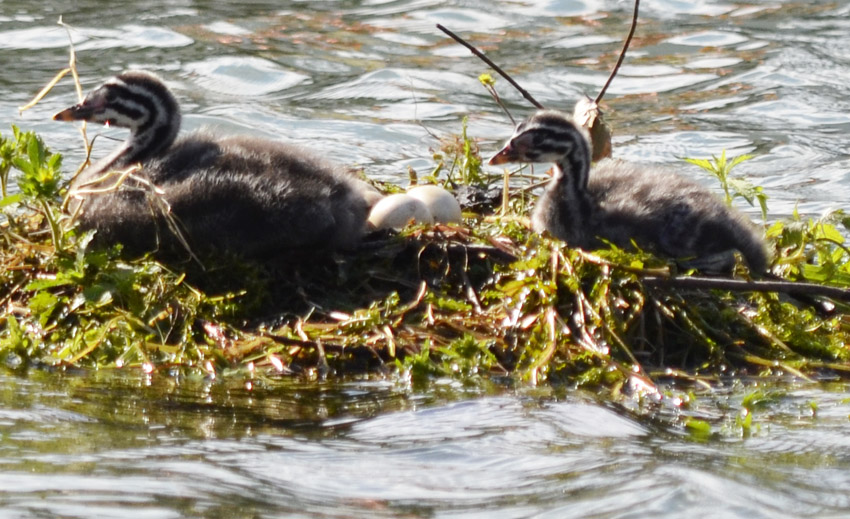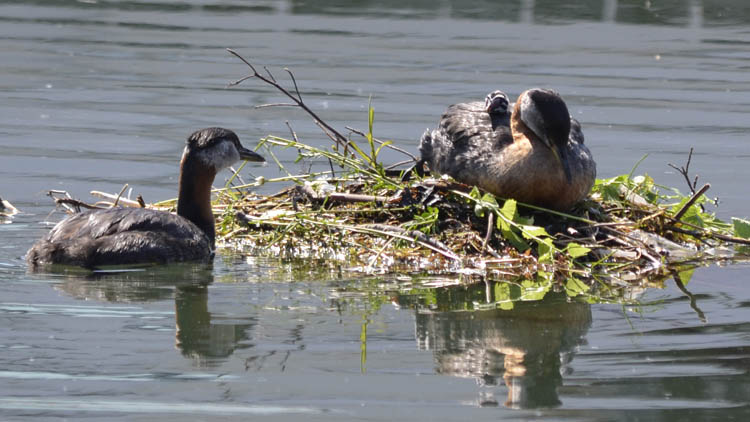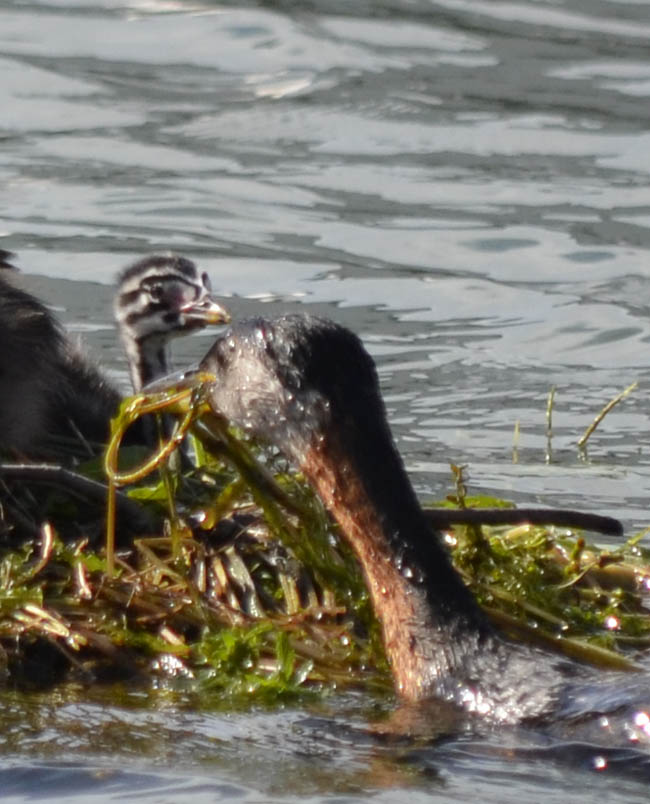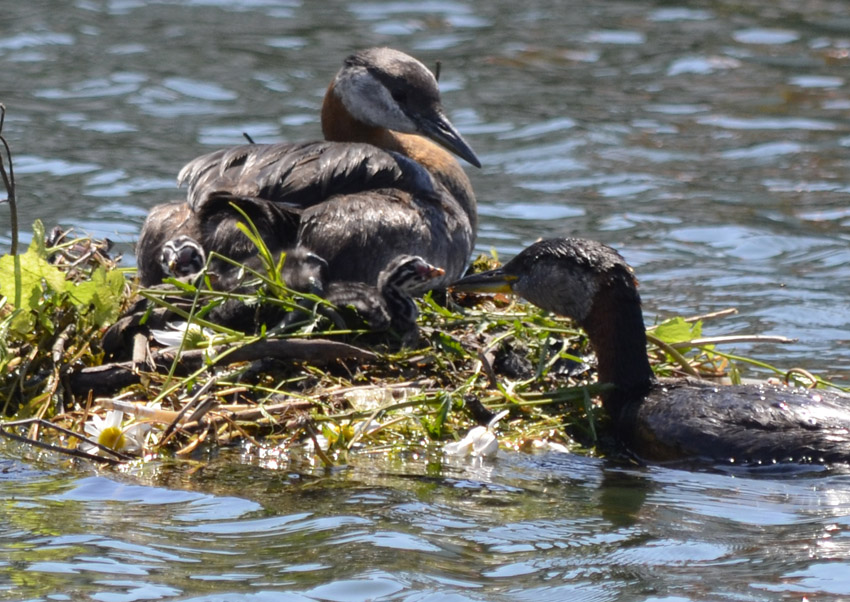On a summer visit to Bronte Outer Harbour Marina in Oakville, near Toronto, I was pleased to see a nest floating in the water. I was even more pleased to see two little zebra-striped heads pop up when Father swam up with a snack. I overheard a human parent telling her child to look at the cute “ducklings.” I’m glad the children got to see them but they weren’t actually ducks. What were these zebra-faced birds?
Red Necked Grebe chicks and eggs. (June 30)
Parents and Chicks Bear No Resemblance to Each Other
If I’d seen the chicks all alone I probably wouldn’t have known what they were. When they are very young, they don’t look like the parents much at all. But these chicks are always with their parents for several weeks. In fact, like loons, the chicks even hitch a ride on their parents’ backs if they leave the nest. They even prefer to sleep on top of Mom or Dad, tucked between the wings, while on the nest, when they’re still small enough to fit.
The Bronte Marina Grebe Family on June 21.
These rusty-necked parents may seem familiar to you if you’ve been reading the other articles on this site. They are Red Necked Grebes. In the spring, I watched their colours changing while I was hunting for an elusive Western Grebe at Colonel Sam Smith Park in Toronto.
Don’t Grebes Usually Nest Up North?
During the winter and especially in early spring, Red Necked Grebes form big flocks on Lake Ontario. They are gathering before they move west and/or north to nest. They like to build their floating homes in shallow water so marshes, small lakes and calmer bays are preferred sites. From the look of the summer habitat map on AllAboutBirds.org they seem to use the sloughs in the prairies as well as the lakes.
Why Do They Nest Afloat?
Nesting on an island of sticks and vegetation helps reduce the number of predators that can reach the nest, eggs and chicks. It has another practical advantage, too.
Like loons, Grebes’ legs and feet are set very far back on their football-shaped bodies. They do not walk well on land nor can they walk far comfortably. With these floating nests they can just inch and flop their way up and onto the eggs. When they wish to go hunting, a quick slide and they’re back into the water where their grace is restored.
How Did This Pair Build a Nest in a Barren Channel at the Marina in Lake Ontario?
Given the description of their natural nests, it seems odd to think of a pair nesting in what is basically a narrow channel between a floating wharf and a limestone-rubble-lined shore. I’m not sure the birds would have picked this spot themselves without prompting.
Dad keeps adding to the nest while one of his chicks watches alertly. (June 21)
Many pairs of Red Necked Grebes do winter in and around the Marina. That led some people to consider encouraging the Grebes to stay and nest. They anchored a platform that is basically a floating tire in the channel. The birds took it from there, transforming it with collected plant material until the base can no longer be seen at all. According to a post in the Hamilton Birders online chat, the Grebes have been nesting here for 17 consecutive years. (Not the same pair of birds, but at the same nesting site.)
Given the close proximity of the nest site to land, the Grebes enjoy a certain fame attracting photographers with amazingly large and complex cameras. They are also featured in iPhone photos emailed by busy parents and grandparents.
On one visit I made this summer, I was speaking with one of these photographers. He said that he watched an older gentleman throwing weeds and cuttings into the channel. The gentleman said he had been helping the Grebes find materials for years. Certainly his offerings were well appreciated. Strand after strand of box elder, garlic mustard and ox-eye daisies were carried over to the nesting raft and added to the mound. I had wondered how the daisies had arrived and was pleased to find out.
How Many Zebra Chicks Does a Pair of Red Necked Grebes Raise?
Can you spot both chicks? One has just been fed by Dad. (June 21)
Nesting success can vary widely for Grebes. At one nesting site at Humber Bay this year, the Grebes hatched two chicks but suffered greatly when a pair of Mute Swans nesting nearby decided to attack. The male Swan killed one of the grebes and destroyed the nest. The other parent was left to try to raise two small chicks with no partner to help. It’s not known (by me) if it was possible. I do hope that the lone grebe paired up with one of the bachelor/lorette grebes also living in that area.
This nest at Bronte was reported to have 1 egg on May 1, 6 eggs on May 24, and 7 eggs in June by various photographers. As recently as July 12, though, there were only 2 chicks. I think that is all they will hatch this year.
Partway through the nesting period the water levels rose in the Lake and the nest was in danger of being swamped. I’m not sure if the eggs actually touched the water or not, but it was close. The parents, however, do keep adding to the nest every time I’ve been by to watch, so it’s possible the eggs just were not fertile or did not develop properly.
Stay tuned!
This chatter about Red Necked Grebes continues in Part 2: Red Necked Grebes Dive into Nesting on Lake Ontario.
Related Reading
- Part Two: Red Necked Grebes Dive into Nesting On Lake Ontario
- Possibly more than you ever wanted to know about Red Necked Grebes from the University of Michigan website
- Let’s Not Get Grebe-y: A Red Necked Sighting Should be Just As Joyful as a Western’s Even in Etobicoke
Join In
Have you visited the Grebes nesting in Oakville or Humber Bay? Please share your experiences with a comment.




